The Island County commissioners have been presented with community feedback gathered by the state Department of Ecology about the recently adopted Shoreline Master Program.
They are now charged with the task of addressing the public’s concerns and submitting those solutions to the state agency by Sept. 23.
While the board has already approved the long-range planning document, it must pass muster with Ecology before it goes into effect.
The public comments were gathered at a May public meeting in Coupeville by the department and then compiled into documentation, which is now being reviewed by county commissioners.
Many public meetings were also held in 2012 by Island County, culminating in the Department of Ecology meeting.
According to Island County Planner Brad Johnson, who presented the documents to the board this week, the state regulator gathered 339 comments from 79 individuals and 16 organizations both during the meeting and afterward, up until the May 24 deadline.
In keeping with previously reported feedback, the agency found public concerns revolved primarily around four issues: non-conforming structures, net-pen aquaculture, shellfish grower requirements and public beach access.
While there was little discussion about the feedback during the work session, the planning department briefly addressed the non-conforming structure issue. The commissioners plan to review the comments and continue the discussion at the Wednesday, Aug. 21, work session where staff will make recommendations based on the community response.
Johnson said according to the agency’s feedback, there seems to be widespread concern that the new shoreline program is more restrictive than the old rules with respect to non-conforming structures on shorelines.
However, he said this is not the case, and in fact the new regulations are less strict in a number of respects.
For instance, the old shoreline plan stated that if a non-conforming structure is damaged or destroyed, it must be brought into compliance if the damage exceeds 75 percent of the structure’s value. Under the new rules, all legally existing residences are allowable and the 75 percent rule applies only to commercial structures, not single family homes.
In regard to net-pen aquaculture, Johnson said the majority of those who provided feedback supported the county’s strict regulations on farmed fish. The commission, however, will need to address the concerns of local shellfish growers on some of the new provisions.
Lastly, Johnson said the public comment was split down the middle on the issue of public access to shorelines, some wanting to ensure public access throughout the island, and others wanting to protect their residential subdivisions from public access.
Adopted by the state Legislature in 1972, the Shorelines Act requires municipalities to adopt master programs that guide development on and around the waterfront, including lakes and rivers. The legislation’s aim is to reduce the impact of development on shorelines.
A new draft of the shoreline management guidelines was adopted in 2003 which required all 39 counties to update their Shoreline Master Plans, all of which are expected to be completed by 2014.
Once the commissioners compile and submit their response, the Department of Ecology has 30 days to issue a decision letter in which they can approve the plan as-is, approve with changes or reject it.



